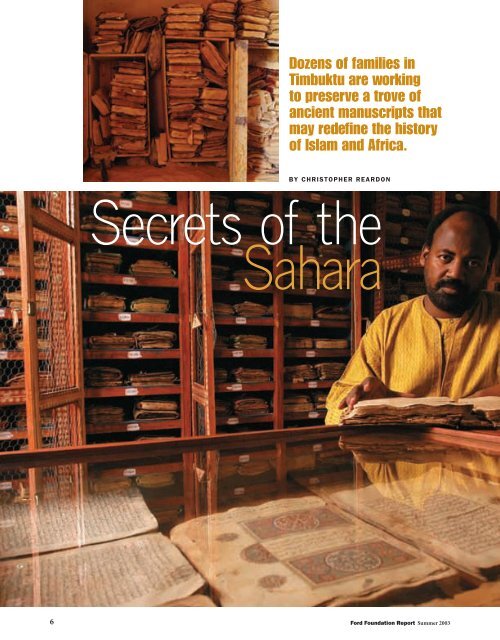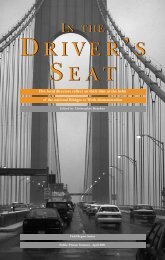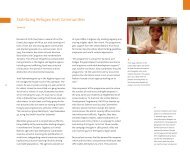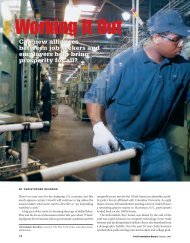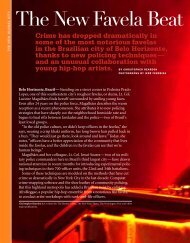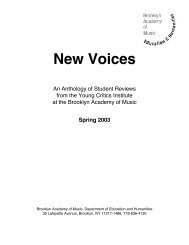Secrets of the Sahara - christopher reardon
Secrets of the Sahara - christopher reardon
Secrets of the Sahara - christopher reardon
You also want an ePaper? Increase the reach of your titles
YUMPU automatically turns print PDFs into web optimized ePapers that Google loves.
Dozens <strong>of</strong> families in<br />
Timbuktu are working<br />
to preserve a trove <strong>of</strong><br />
ancient manuscripts that<br />
may redefine <strong>the</strong> history<br />
<strong>of</strong> Islam and Africa.<br />
BY CHRISTOPHER REARDON<br />
<strong>Secrets</strong> <strong>of</strong> <strong>the</strong><br />
<strong>Sahara</strong><br />
6 Ford Foundation Report Summer 2003
Timbuktu, Mali—As dusk sweeps across <strong>the</strong> <strong>Sahara</strong> Desert,<br />
<strong>the</strong> Es Sayouti bro<strong>the</strong>rs—six learned men ranging from 40 to<br />
55 years old—ga<strong>the</strong>r in <strong>the</strong>ir parents’home to reflect on <strong>the</strong> vexing<br />
legacy <strong>the</strong>y share. Abdrahamane speaks first, as he is <strong>the</strong><br />
eldest and <strong>the</strong> imam at <strong>the</strong> nearby Djingarey Ber Mosque, a<br />
place <strong>of</strong> prayer and scholarship since 1325. He explains that<br />
<strong>the</strong>ir fa<strong>the</strong>r, who is in failing health and resting downstairs, has<br />
recently given <strong>the</strong>m responsibility for 2,500 ancient texts ga<strong>the</strong>ring<br />
dust in <strong>the</strong> next room.<br />
“Our forefa<strong>the</strong>rs have left <strong>the</strong>se manuscripts to future generations,<br />
and we must do <strong>the</strong> same,” says Abdrahamane. “The<br />
problems we face are how to keep <strong>the</strong>m in good condition and<br />
how to make <strong>the</strong>m available to scholars.”<br />
The magnitude <strong>of</strong> <strong>the</strong>se challenges becomes clear when he<br />
opens <strong>the</strong> doors to a large wooden cabinet,<br />
its shelves piled high with brittle<br />
manuscripts dating back to <strong>the</strong> 14th century.<br />
Some have been damaged by fire and<br />
termites, o<strong>the</strong>rs by flooding and high<br />
humidity during <strong>the</strong> rainy season. One <strong>of</strong><br />
<strong>the</strong> bro<strong>the</strong>rs opens an illuminated copy<br />
<strong>of</strong> <strong>the</strong> Koran from <strong>the</strong> 1600’s. Abdrahamane<br />
leafs through a treatise on optics<br />
and astronomy, with diagrams depicting<br />
<strong>the</strong> motions <strong>of</strong> <strong>the</strong> planets in black and<br />
red ink. It dates from <strong>the</strong> 1300’s, long<br />
before Galileo, Kepler or even Copernicus<br />
made <strong>the</strong>ir marks in Europe.<br />
The Es Sayouti bro<strong>the</strong>rs are not alone.<br />
In recent years, 300 private collections<br />
have come to light in Mali, <strong>the</strong> bulk <strong>of</strong><br />
<strong>the</strong>m in Timbuktu, a city <strong>of</strong> 60,000 people<br />
on <strong>the</strong> sou<strong>the</strong>rn edge <strong>of</strong> <strong>the</strong> <strong>Sahara</strong><br />
Desert. Toge<strong>the</strong>r <strong>the</strong>se collections hold as<br />
many as one million manuscripts, ranging<br />
from one to 500 pages each. Most are<br />
written in Arabic, although some use Arabic<br />
script to transliterate local tongues<br />
that had no written counterpart.<br />
Researchers who have taken a preliminary<br />
look at some <strong>of</strong> <strong>the</strong>se texts say <strong>the</strong>y<br />
shed light on important facets <strong>of</strong> social<br />
history and religious thought and practice<br />
before <strong>the</strong> colonial era began in <strong>the</strong> 19th<br />
century. Upon closer inspection, <strong>the</strong>y may<br />
PHOTOGRAPHS THIS SPREAD: XAVIER ROSSI/GAMMA<br />
Abdoul Kader Haïdara, one <strong>of</strong> Timbuktu’s<br />
leading manuscript experts, opened<br />
<strong>the</strong> city’s first private archive in 1998.<br />
It contains scientific treatises, Islamic<br />
sermons, legal documents, medical<br />
commentaries and poetry.<br />
Opposite A family library in Bouj Beha,<br />
150 miles north <strong>of</strong> Timbuktu, holds<br />
manuscripts, dating back several<br />
centuries, that are endangered by<br />
poor storage conditions.<br />
compel scholars to rewrite <strong>the</strong> history <strong>of</strong> Islam and <strong>of</strong> Africa and<br />
to abolish once and for all <strong>the</strong> persistent Western stereotype <strong>of</strong><br />
black Africans as primitive and lacking in intellectual traditions.<br />
“These manuscripts have been here all along,”says Stephanie<br />
Diakité, an American scholar who advises <strong>the</strong> Malian government.<br />
“What’s revolutionary is that <strong>the</strong>y are finally being recognized<br />
as manifestations <strong>of</strong> everyday culture within a highly<br />
literate society. They did not come like a bolt out <strong>of</strong> <strong>the</strong> blue. They<br />
are vestiges <strong>of</strong> people living <strong>the</strong>ir lives and writing things down,<br />
as all civilized cultures do.”<br />
Many <strong>of</strong> <strong>the</strong> ancient texts date back to <strong>the</strong> Songhaï empire,<br />
a prosperous kingdom that peaked in <strong>the</strong> 15th and 16th centuries.<br />
Today, Timbuktu relies on arts and crafts for <strong>the</strong> tourist<br />
industry and on nomadic herding to subsist. But five or six centuries<br />
ago, it was a major crossroads for caravans <strong>of</strong> gold and salt<br />
traversing <strong>the</strong> <strong>Sahara</strong>. The book trade also flourished, and <strong>the</strong><br />
city’s Sankoré Mosque became a center <strong>of</strong> learning, attracting<br />
thousands <strong>of</strong> students each year. Even today, a small number <strong>of</strong><br />
people live <strong>of</strong>f <strong>the</strong> traditions <strong>of</strong> scholarship, writing or interpreting<br />
texts.<br />
The larger books—hundreds <strong>of</strong> unbound pages wrapped in<br />
lea<strong>the</strong>r covers—<strong>of</strong>ten include a colophon, a statement about<br />
<strong>the</strong>ir authorship and production. Some identify <strong>the</strong> author, <strong>the</strong><br />
person who commissioned a new copy, <strong>the</strong> calligrapher who<br />
copied <strong>the</strong> text, <strong>the</strong> person who verified that it was accurate and<br />
<strong>the</strong> artisans who gilded <strong>the</strong> illustrations and prepared <strong>the</strong> lea<strong>the</strong>r<br />
binding. Diakité, a master bookbinder who holds a doctorate<br />
in law, ano<strong>the</strong>r in international development and an M.B.A.,<br />
says <strong>the</strong>se colophons likely served as legal contracts, with names,<br />
dates and fees.<br />
“The manuscripts talk about everything,”says Abdoul Kader<br />
Haïdara, 38, who opened <strong>the</strong> city’s first private archive, <strong>the</strong><br />
Mamma Haïdara Memorial Library, in 1998. “There are copies<br />
<strong>of</strong> <strong>the</strong> Koran and hadiths [sayings <strong>of</strong> <strong>the</strong> prophet Muhammad]<br />
as well as sermons and explanations <strong>of</strong> Islamic law. There are<br />
treatises on astronomy, ma<strong>the</strong>matics, medicine and geography.<br />
There are poems and folk tales.”<br />
He adds: “We have found contracts on slavery; commercial<br />
records that document <strong>the</strong> gold and salt trades; letters and decrees<br />
showing how Muslim jurists resolved conflicts between families<br />
and states. Some <strong>of</strong> <strong>the</strong> manuscripts talk about women’s<br />
rights and children’s rights. O<strong>the</strong>rs are family histories and chronicles<br />
<strong>of</strong> political and economic life as far back as <strong>the</strong> 11th century.”<br />
Abdoul Kader is one <strong>of</strong> Timbuktu’s leading manuscript<br />
experts, and <strong>the</strong> son <strong>of</strong> a renowned local collector, Mamma<br />
Haïdara. While growing up, he spent long hours at his fa<strong>the</strong>r’s<br />
side, reading <strong>the</strong> family’s manuscripts and learning how to care<br />
for <strong>the</strong>m. When Abdoul Kader was just 17, his fa<strong>the</strong>r died, leaving<br />
<strong>the</strong> venerable collection in his young hands.<br />
Aided by a generally arid climate, people in Timbuktu have<br />
managed this task for centuries. But time is working against<br />
<strong>the</strong>m. The <strong>Sahara</strong> has been inching south and sand is filling <strong>the</strong><br />
city streets, which contributes to flooding in <strong>the</strong> brief rainy sea-<br />
Christopher Reardon writes for The New York Times and o<strong>the</strong>r major<br />
publications.<br />
Ford Foundation Report Summer 2003 7
XAVIER ROSSI/GAMMA<br />
CHRISTOPHER REARDON<br />
son. Acidic paper and ferrous<br />
inks introduced in <strong>the</strong> 19th<br />
century are slowly burning<br />
through adjacent manuscripts;<br />
metal trunks <strong>of</strong> similar vintage<br />
contract and sweat depending<br />
on <strong>the</strong> wea<strong>the</strong>r, causing books<br />
to buckle and rot. And termites<br />
seem to be everywhere. Consequently,<br />
many owners in<br />
Mali, a landlocked country that<br />
ranks among <strong>the</strong> poorest in <strong>the</strong><br />
world, see <strong>the</strong>ir stewardship <strong>of</strong><br />
Three scholars on <strong>the</strong> site <strong>of</strong><br />
a new library to house <strong>the</strong><br />
Kati collection <strong>of</strong> manuscripts<br />
once scattered among several<br />
branches <strong>of</strong> <strong>the</strong> family.<br />
Top Abdrahamane Es Sayouti<br />
on <strong>the</strong> ro<strong>of</strong> <strong>of</strong> <strong>the</strong> Djingarey<br />
Ber Mosque, where he is <strong>the</strong><br />
imam. He is one <strong>of</strong> six bro<strong>the</strong>rs<br />
charged with protecting<br />
<strong>the</strong> family’s legacy <strong>of</strong> precious<br />
manuscripts.<br />
<strong>the</strong>se texts as both a sacred honor and a costly burden.<br />
“These manuscripts are very expensive for <strong>the</strong> family,” says<br />
one <strong>of</strong> <strong>the</strong> Es Sayouti bro<strong>the</strong>rs, an engineer named Alpha Sane.<br />
“But we fear <strong>the</strong> judgment <strong>of</strong> our sons and grandsons if we let<br />
<strong>the</strong>m disappear.”<br />
An Emerging Network<br />
The first concerted effort to save Mali’s ancient manuscripts<br />
got under way in 1970, when UNESCO helped establish <strong>the</strong><br />
Ahmed Baba Center for Documentation and Research in Timbuktu.<br />
Named after one <strong>of</strong> <strong>the</strong> city’s leading 16th-century scholars,<br />
<strong>the</strong> center was envisioned as a place where <strong>the</strong>se texts could<br />
be restored, catalogued and made accessible to researchers. It<br />
got <strong>of</strong>f to a promising start, led by its founding director, Mahmoud<br />
Zouber, who spoke six languages and wrote his dissertation<br />
on Baba while at <strong>the</strong> Sorbonne. (It was published in<br />
France in 1977.)<br />
The center borrowed its initial holdings from private collectors,<br />
but its long-term plan was to buy manuscripts from families<br />
that could no longer care for <strong>the</strong>m. Although it acquired a<br />
few thousand manuscripts, many owners refused to part with<br />
texts <strong>the</strong>ir families had held for generations—even if it meant<br />
watching <strong>the</strong>m slowly turn to dust. Zouber sought to win over<br />
such heirs by enlisting Abdoul Kader Haïdara as a prospector.<br />
As <strong>the</strong> son <strong>of</strong> a well-liked collector, Haïdara stood a better chance<br />
<strong>of</strong> getting his foot in <strong>the</strong> door, but closing a deal ultimately<br />
rested on his own expertise and charisma.<br />
Once, for example, Haïdara visited a family in Rharrous, 100<br />
miles down river from Timbuktu. The fa<strong>the</strong>r, a local marabou,<br />
or shaman, had recently died, leaving a wife, several young children,<br />
and a small case filled with manuscripts. “At first <strong>the</strong><br />
marabou’s wife refused to sell,” Haïdara recalls. “She said that<br />
<strong>the</strong> texts belonged to her children, and that we would have to<br />
wait for <strong>the</strong>m to grow up before touching <strong>the</strong>ir inheritance. I<br />
showed her that termites had already destroyed some <strong>of</strong> <strong>the</strong><br />
manuscripts, and soon <strong>the</strong>y would take <strong>the</strong> rest. By <strong>the</strong> time<br />
<strong>the</strong> children reached adulthood, <strong>the</strong>ir fa<strong>the</strong>r’s legacy would be<br />
nothing but a pile <strong>of</strong> dust.”<br />
Then Haïdara revised his <strong>of</strong>fer. Instead <strong>of</strong> paying cash, he<br />
would trade two young cows for <strong>the</strong> manuscripts. That way, he<br />
said, <strong>the</strong> children would have an asset that gained value over<br />
time, unlike <strong>the</strong> decaying manuscripts. This time <strong>the</strong> widow<br />
accepted. “Two years later I went back to Rharrous, and <strong>the</strong>y were<br />
thrilled to see me,” Haïdara says. “The two cows had bred and<br />
become four. The family told <strong>the</strong>ir relatives, and suddenly everyone<br />
<strong>the</strong>re was ready to sell to me.”<br />
Between 1984 and 1996, Haïdara acquired 12,000 manuscripts<br />
for <strong>the</strong> center. Gradually, though, he came to wonder if consolidating<br />
Mali’s ancient texts was <strong>the</strong> best way to save <strong>the</strong>m. As<br />
8 Ford Foundation Report Summer 2003
a collector who had inherited thousands <strong>of</strong> manuscripts from<br />
his parents—and bought hundreds more on his own—he<br />
understood <strong>the</strong> widespread reluctance to part with a cherished<br />
family legacy.<br />
With help from Henry Louis Gates, Jr., who heads <strong>the</strong> Afro-<br />
American Studies program at Harvard, Haïdara raised money<br />
for a library to house his collection. The Al-Furqan Islamic Heritage<br />
Foundation in London funded his efforts to catalog <strong>the</strong> collection.<br />
Al-Furqan will publish <strong>the</strong> final volume <strong>of</strong> <strong>the</strong> catalog<br />
later this year.<br />
In recent years, Haïdara and o<strong>the</strong>r local collectors have been<br />
working on a new approach to preserving <strong>the</strong> ancient<br />
manuscripts. Toge<strong>the</strong>r, <strong>the</strong>y are trying to develop a network <strong>of</strong><br />
private libraries that would enable owners to share resources<br />
and speak collectively, yet allow families to retain possession <strong>of</strong><br />
<strong>the</strong>ir manuscripts. As a first step, <strong>the</strong>y started <strong>the</strong> Association for<br />
<strong>the</strong> Safekeeping <strong>of</strong> Ancient Manuscripts, which now represents<br />
23 private collections in Timbuktu.<br />
“My dream is that in 20 years’ time, all <strong>the</strong>se manuscripts<br />
will be restored and digitized and begun to be published,” says<br />
Haïdara. “Because after that, scholars can read <strong>the</strong>m and analyze<br />
<strong>the</strong>ir significance in human history.”<br />
The association educates owners about <strong>the</strong> importance <strong>of</strong><br />
<strong>the</strong> manuscripts <strong>the</strong>y have inherited and shows <strong>the</strong>m how to<br />
store texts properly. Ultimately, it hopes to mount expositions<br />
in Timbuktu and abroad so <strong>the</strong> manuscripts can reach a wider<br />
audience (see p. 11). The association faced an important test<br />
earlier this year, after a pair <strong>of</strong> entrepreneurs from abroad persuaded<br />
several owners to sign away <strong>the</strong> rights to restore or<br />
exhibit <strong>the</strong>ir manuscripts. The contract was written in English,<br />
which none <strong>of</strong> <strong>the</strong> owners could read or speak. The association<br />
stepped in and drafted a declaration renouncing it.<br />
The emerging network <strong>of</strong> private libraries still leaves a pivotal<br />
role for <strong>the</strong> Ahmed Baba Center, which was renamed <strong>the</strong><br />
Ahmed Baba Institute for Advanced Study and Islamic Research<br />
three years ago. The association encourages owners <strong>of</strong> small<br />
collections to sell or lend <strong>the</strong>ir manuscripts to <strong>the</strong> institute for<br />
safekeeping. Meanwhile, owners <strong>of</strong> larger collections can turn<br />
to <strong>the</strong> institute for conservation or cataloguing services.<br />
The institute, which is funded by Mali’s Ministry <strong>of</strong> Higher<br />
African Islamic Civilization<br />
Revealed<br />
The Ford Foundation supports <strong>the</strong> preservation and<br />
study <strong>of</strong> Timbuktu’s ancient manuscripts in several ways.<br />
A grant from <strong>the</strong> foundation’s <strong>of</strong>fice in Lagos, Nigeria, has<br />
made it possible for Stephanie Diakité to train 16 local<br />
residents to conserve, catalogue and digitize manuscripts<br />
at <strong>the</strong> Ahmed Baba Institute for Advanced Study and<br />
Islamic Research. Meanwhile, a grant from <strong>the</strong> Religion,<br />
Society, and Culture program in New York helped<br />
establish <strong>the</strong> Institute for <strong>the</strong> Study <strong>of</strong> Islamic Thought<br />
in Africa. Based at Northwestern University, it seeks to<br />
foster a network <strong>of</strong> scholars from African and o<strong>the</strong>r<br />
universities who have <strong>the</strong> linguistic and o<strong>the</strong>r knowledge<br />
necessary to analyze <strong>the</strong> African Islamic civilization <strong>the</strong>se<br />
documents reveal, with an eye to learning more about<br />
how Islam developed in Africa.<br />
Education but acts with relative autonomy, is still adjusting to<br />
this new role. “We think <strong>the</strong>re are advantages to keeping <strong>the</strong><br />
manuscripts in one place,” says Mohamed Gallah Dicko, who<br />
succeeded Zouber as director in 1996. “Among o<strong>the</strong>r things,<br />
it’s easier for researchers to access <strong>the</strong>m. But we fully welcome<br />
<strong>the</strong> arrival <strong>of</strong> <strong>the</strong>se private libraries. We are ready to help <strong>the</strong>m.”<br />
Two years ago <strong>the</strong> institute held a 12-week workshop to train<br />
seven local artisans in <strong>the</strong> art <strong>of</strong> book conservation. Stephanie<br />
Diakité, who led <strong>the</strong> workshop, says many <strong>of</strong> <strong>the</strong> artisans were<br />
descendants <strong>of</strong> <strong>the</strong> gilders and binders who worked on<br />
manuscripts generations ago. One trainee went home and looked<br />
through his tool chest, but couldn’t identify some <strong>of</strong> <strong>the</strong> tools,<br />
which he inherited from his ancestors. Diakité recognized <strong>the</strong>m<br />
as stamping tools for bookbinding, and showed <strong>the</strong> trainee how<br />
to use <strong>the</strong>m.<br />
“These are generational artisans, but in many cases <strong>the</strong> skills<br />
have been lost,”she says. “It’s fascinating to see <strong>the</strong>m make those<br />
connections again.”<br />
The Spanish Connection<br />
One <strong>of</strong> <strong>the</strong> most unusual collections in Timbuktu is held by<br />
Ismaël Diadié Haïdara, a local scholar who spends half his time<br />
lecturing at <strong>the</strong> University <strong>of</strong> Granada in Spain. He and Abdoul<br />
Kader Haïdara share a last name, but <strong>the</strong>y are not related, as<br />
<strong>the</strong>y explained one evening over dinner in Abdoul Kader’s home.<br />
“He is a Sharifa,” says Ismaël, naming a scholarly clan from<br />
Bamba, 130 miles down river.<br />
“And he is a Quti, a Goth,” replies Abdoul Kader, referring to<br />
<strong>the</strong> Christians who drove <strong>the</strong> Muslims out <strong>of</strong> <strong>the</strong> Iberian peninsula<br />
in 1492.<br />
He is making a joke, but it plays on a kernel <strong>of</strong> truth. Although<br />
Ismaël is a devout Muslim with darker skin than Abdoul Kader,<br />
some <strong>of</strong> his ancestors came from Toledo when it was <strong>the</strong> seat <strong>of</strong><br />
Christian power in nor<strong>the</strong>rn Spain. On May 22, 1468, as religious<br />
intolerance mounted, Ali b. Ziyad al-Quti set out to make a new<br />
life in what he called “<strong>the</strong> land <strong>of</strong> <strong>the</strong> blacks.”He passed through<br />
<strong>the</strong> Muslim kingdom <strong>of</strong> Granada to Gibraltar and from <strong>the</strong>re<br />
to Africa. Then, traveling by caravan, he continued through<br />
present-day Morocco, Algeria and Mauritania. Unlike many<br />
Muslims, he did not identify ethnically with Arabs or Berbers.<br />
Instead, he called himself al-Quti, <strong>the</strong> Goth.<br />
In 1471 Ali settled in Goumbou (now a city in Mali), where<br />
he married <strong>the</strong> sister <strong>of</strong> Askia Mohamed, a black Muslim warrior<br />
who went on to rule <strong>the</strong> Songhaï empire for 37 years. Their<br />
son, Mahmud Kati, became Askia’s finance minister, directed <strong>the</strong><br />
empire’s first census, served as a qadi, or judge, and stood second<br />
in line to <strong>the</strong> throne. As a man <strong>of</strong> letters, Kati not only collected<br />
books but also wrote an important history <strong>of</strong> <strong>the</strong> empire,<br />
<strong>the</strong> sprawling Tarikh Al-Fettach, known in English as <strong>the</strong> “Chronicle<br />
<strong>of</strong> <strong>the</strong> Seeker <strong>of</strong> Knowledge.” (Historians are still debating<br />
whe<strong>the</strong>r he or his descendants finished <strong>the</strong> book, which was<br />
translated into French in 1913 from a copy loaned by <strong>the</strong> Es<br />
Sayouti family.)<br />
When Kati died, he left dozens <strong>of</strong> letters and books to his<br />
son Ismaël, who added to <strong>the</strong> collection and <strong>the</strong>n passed it on<br />
to his <strong>of</strong>fspring. So it went for generations, until Kati’s collection<br />
was divided among different branches <strong>of</strong> <strong>the</strong> family in <strong>the</strong><br />
19th century.<br />
In August 1999, Ismaël Haïdara began to reassemble <strong>the</strong> Kati<br />
Ford Foundation Report Summer 2003 9
A street scene in Timbuktu,<br />
Mali, where scholars are<br />
using modern technology to<br />
preserve ancient manuscripts<br />
and make <strong>the</strong>m accessible.<br />
collection.He met with cousins<br />
in Thié and Kirchamba, hauling<br />
back trunks <strong>of</strong> manuscripts<br />
to his home in Timbuktu. A<br />
few weeks later he showed<br />
some <strong>of</strong> <strong>the</strong>m to John Hunwick,<br />
a British historian who<br />
was a Western pioneer <strong>of</strong> <strong>the</strong><br />
study <strong>of</strong> Islamic thought in precolonial<br />
Africa. Hunwick was<br />
awed by what he saw: a trove<br />
<strong>of</strong> manuscripts dating back to <strong>the</strong> 14th century. Most were written<br />
in Arabic; o<strong>the</strong>rs used Arabic script to record ideas expressed<br />
in Fulani and o<strong>the</strong>r spoken languages. The papers included academic<br />
treatises, sermons, legal documents and poetry by women.<br />
Most significantly, <strong>the</strong> core <strong>of</strong> <strong>the</strong> collection can be traced to<br />
Mahmud Kati, providing a palpable sense <strong>of</strong> how black Muslim<br />
scholars in Timbuktu wrestled with ideas and passed on<br />
knowledge in <strong>the</strong> 15th and 16th centuries. Previously, most<br />
scholarship in <strong>the</strong> field has focused on individual texts, not on<br />
<strong>the</strong> body <strong>of</strong> work that a single scholar would have studied.<br />
“Library studies are a fairly recent field <strong>of</strong> intellectual history,<br />
and one that has not been much explored in Islamic studies<br />
where research has concentrated on individual authors and<br />
<strong>the</strong>ir works,” says Albrecht H<strong>of</strong>heinz, a German scholar who<br />
conducted a preliminary survey <strong>of</strong> <strong>the</strong> Kati collection a few<br />
years ago. “The study <strong>of</strong> libraries as collections, on <strong>the</strong> o<strong>the</strong>r<br />
hand, helps us to gain insights into <strong>the</strong> composition <strong>of</strong> learning,<br />
<strong>the</strong> spread and ‘popularity’ <strong>of</strong> certain texts, which allows us<br />
better to understand <strong>the</strong> intellectual formation <strong>of</strong> educated<br />
people at <strong>the</strong> time. This makes <strong>the</strong> Kati library a unique treasure<br />
for <strong>the</strong> intellectual history <strong>of</strong> <strong>the</strong> Middle Niger region.”<br />
The manuscripts are also noteworthy, H<strong>of</strong>heinz and Hunwick<br />
say, because Kati and o<strong>the</strong>rs jotted extensive notes in <strong>the</strong><br />
margins. Some comment directly on <strong>the</strong> text. But because paper<br />
was scarce, many are entirely unrelated observations about weddings,<br />
funerals and abundant rains. One, signed by Kati, appears<br />
to describe a meteor shower:<br />
“In <strong>the</strong> year 991 in God’s month <strong>of</strong> Rajab <strong>the</strong> Goodly [August<br />
1583] after half <strong>the</strong> night had passed, stars flew around <strong>the</strong> sky<br />
as if fire had been kindled in <strong>the</strong> whole sky—east, west, north<br />
and south. It became a mighty flame lighting up <strong>the</strong> earth, and<br />
people were extremely disturbed about that. It continued until<br />
after dawn.”<br />
Construction is now under way for a library to house <strong>the</strong><br />
Kati collection, which encompasses more than 7,000<br />
manuscripts. The Spanish government is funding <strong>the</strong> building,<br />
which wraps around a central courtyard in <strong>the</strong> Andalusian style.<br />
“I come from a family <strong>of</strong> writers,”says Ismaël, who published<br />
a family history in Spain a few years ago. “We have been writing<br />
for 15 generations, so writing comes easily to me. The harder<br />
challenge I face is how to catalog, restore and digitize <strong>the</strong><br />
manuscripts my ancestors have left behind.”<br />
A Closer Reading<br />
During <strong>the</strong> colonial era, European scholars routinely took<br />
cultural artifacts out <strong>of</strong> Africa, ostensibly to forestall <strong>the</strong> ravages<br />
<strong>of</strong> time, wea<strong>the</strong>r, political instability and social upheaval.<br />
Africans no longer buy that argument, which was <strong>of</strong>ten a thinly<br />
veiled excuse for usurping <strong>the</strong>ir cultural inheritance. Yet collectors<br />
in Timbuktu recognize both <strong>the</strong> difficulty <strong>of</strong> preserving<br />
<strong>the</strong>ir manuscripts and <strong>the</strong> importance <strong>of</strong> making <strong>the</strong>m accessible<br />
to researchers around <strong>the</strong> globe.<br />
“These manuscripts talk about a vital period in our region’s<br />
history,”says one <strong>of</strong> <strong>the</strong> Es Sayouti bro<strong>the</strong>rs, an engineer named<br />
Alpha Sané. “But <strong>the</strong>y are not just <strong>of</strong> local interest. They hold<br />
significance for all humanity.”<br />
The city’s leading collectors are embracing modern technology<br />
as a tool for preservation and scholarship. The Ahmed<br />
Baba Institute, for instance, has trained eight local residents to<br />
scan and catalog ancient texts. Page by page, <strong>the</strong>y are generating<br />
digital images <strong>of</strong> important manuscripts. Moreover, <strong>the</strong>y are<br />
compiling a searchable database that identifies up to 33 features<br />
<strong>of</strong> each text—including <strong>the</strong> author, <strong>the</strong> date it was copied,<br />
and a summary <strong>of</strong> <strong>the</strong> text. It is painstaking work. So far, <strong>the</strong>y<br />
have catalogued 1,000 <strong>of</strong> <strong>the</strong> institute’s 20,000 manuscripts.<br />
The Mamma Haïdara Memorial Library and <strong>the</strong> Kati Collection<br />
are also starting to digitize <strong>the</strong>ir manuscripts.<br />
But computers are no more a panacea than <strong>the</strong> sturdy metal<br />
boxes introduced in <strong>the</strong> 19th century. Conservationists worry<br />
that <strong>the</strong> scanning process, which entails handling <strong>the</strong> manuscripts<br />
and exposing <strong>the</strong>m to bright light, may hasten <strong>the</strong>ir deterioration.<br />
Owners have raised concerns about ethical and copyright<br />
issues, noting that digital images can be easily copied and<br />
exploited. Even computer experts admit that, given <strong>the</strong> uncertain<br />
life <strong>of</strong> compact disks and o<strong>the</strong>r media, as well as <strong>the</strong> rapid<br />
obsolescence <strong>of</strong> particular file formats, <strong>the</strong>se digital images may<br />
not withstand <strong>the</strong> test <strong>of</strong> time. Yet <strong>the</strong> consensus is that <strong>the</strong> benefits<br />
<strong>of</strong> scanning outweigh <strong>the</strong>se misgivings.<br />
In <strong>the</strong> coming years, <strong>the</strong> Ministry <strong>of</strong> Education hopes students<br />
in Mali will begin to explore <strong>the</strong> history contained in <strong>the</strong> ancient<br />
manuscripts, starting at <strong>the</strong> university level and <strong>the</strong>n in primary<br />
and secondary schools. “There are so many priorities in<br />
Africa,” says Diakité, who advises <strong>the</strong> ministry. “It’s very diffi-<br />
WOLFGANG KAEHLER/CORBIS<br />
10 Ford Foundation Report Summer 2003
cult to take a long-term view. But reintroducing indigenous<br />
culture into <strong>the</strong> educational system can instill dignity and purpose.<br />
It’s a powerful tool for development.”<br />
Meanwhile, scholars abroad are working to develop a network<br />
<strong>of</strong> young African researchers who can read, edit and translate<br />
<strong>the</strong> manuscripts in Timbuktu—and o<strong>the</strong>rs like <strong>the</strong>m in<br />
Mauritania, Nigeria and Zanzibar. The nucleus <strong>of</strong> <strong>the</strong>se efforts<br />
is Chicago’s Northwestern University, where Hunwick, <strong>the</strong> British<br />
historian, founded <strong>the</strong> Institute for <strong>the</strong> Study <strong>of</strong> Islamic Thought<br />
in Africa in 2000.<br />
The institute aims to bridge <strong>the</strong> gap between scholarship on<br />
Islam and scholarship on Africa. Scholars <strong>of</strong> Islam tend to ignore<br />
its development in Africa,Hunwick explains,despite <strong>the</strong> vast number<br />
<strong>of</strong> Muslims <strong>the</strong>re. Likewise, many Africanists consider Islam<br />
marginal to <strong>the</strong>ir field. And scholars <strong>of</strong> religion largely overlook<br />
both <strong>the</strong> study <strong>of</strong> Islam in Africa and <strong>the</strong> study <strong>of</strong> religion in Africa<br />
in general. Through publications, symposia and fellowships for<br />
African researchers, <strong>the</strong> institute seeks to show that <strong>the</strong>se fields<br />
are more closely intertwined than most scholars recognize.<br />
“We hope, too, to enlighten <strong>the</strong> general public as to <strong>the</strong> role<br />
that Islam has played in African societies,” Hunwick says, “and<br />
to <strong>the</strong> fact that much <strong>of</strong> Africa has long enjoyed literacy and an<br />
intellectual life—matters that may help to erase some <strong>of</strong> <strong>the</strong><br />
unfortunate stereotypes about Africa… [Then] Timbuktu will<br />
cease to be seen just as a legendary fantasy, and will be recognized<br />
for what it really was—a spiritual and intellectual jewel<br />
inspired by <strong>the</strong> Islamic faith.”<br />
Indeed, <strong>the</strong> world <strong>the</strong>se manuscripts reveal is one in which<br />
a tremendous volume <strong>of</strong> goods and ideas flowed across <strong>the</strong><br />
<strong>Sahara</strong> in all directions—linking Europe, Africa and Arabia. If<br />
not for <strong>the</strong> families who have preserved <strong>the</strong>se texts all <strong>the</strong>se<br />
years, this vibrant past might have been lost forever.<br />
“When we speak, <strong>the</strong> words disappear,” says Alpha Sané Ben<br />
Es Sayouti, who dreams <strong>of</strong> opening a private library to house<br />
his fa<strong>the</strong>r’s collection. “But what is written should remain for<br />
all time.” ■<br />
Coming to America:<br />
Scholars <strong>of</strong> Peace<br />
In <strong>the</strong>se turbulent times, it’s tempting to reduce <strong>the</strong> economic,<br />
political and religious tensions felt in many parts <strong>of</strong> <strong>the</strong><br />
world to a straightforward “clash <strong>of</strong> civilizations.” This notion<br />
that Islam is inherently incompatible with Western culture<br />
may sound credible at first, but it trivializes <strong>the</strong> complexities<br />
<strong>of</strong> both Islam and <strong>the</strong> West. A landmark exhibition this summer<br />
in Washington, D.C., may help to set <strong>the</strong> record straight.<br />
In June <strong>the</strong> Mamma Haïdara Memorial Library in Timbuktu,<br />
Mali, will send 23 ancient manuscripts to <strong>the</strong> Library <strong>of</strong> Congress<br />
for a rare and timely exhibit. Three <strong>of</strong> <strong>the</strong> manuscripts concern<br />
conflict resolution, while <strong>the</strong> o<strong>the</strong>rs include religious teachings,<br />
medieval sciences, literature, historical records and mystical<br />
treatises. The show, which runs from June 24 to Sept. 3,<br />
marks <strong>the</strong> first time <strong>the</strong>se texts have left Africa. It coincides<br />
with <strong>the</strong> 2003 Smithsonian Folklife Festival, where Mali will<br />
share <strong>the</strong> spotlight with Scotland and Appalachia. (The festival<br />
runs from June 25 through July 6 on <strong>the</strong> National Mall.)<br />
“There’s a lot <strong>of</strong> material in this collection on conflict resolution,<br />
good governance and tolerance within <strong>the</strong> law and<br />
social structures,” says Abdoul Kader Haïdara, who directs<br />
<strong>the</strong> Mamma Haïdara Memorial Library. “By bringing <strong>the</strong>se<br />
manuscripts to <strong>the</strong> United States, we hope to show that <strong>the</strong>se<br />
ideas and practices have a valued place in Islamic tradition.”<br />
A few years ago Haïdara joined forces with three o<strong>the</strong>r<br />
manuscript experts in Mali—Stephanie Diakité, Mamadou<br />
Diallo and Mahmoud Zouber—to promote scholarship on<br />
this overlooked history. After forming a research group, <strong>the</strong>y<br />
wrote a paper toge<strong>the</strong>r about some <strong>of</strong> <strong>the</strong> “scholars <strong>of</strong> peace”<br />
who drew on Islamic <strong>the</strong>ology to resolve conflicts between<br />
individuals, families, communities and governments in West<br />
Africa. The paper, citing numerous manuscripts in Timbuktu,<br />
describes some <strong>of</strong> <strong>the</strong> techniques that scholars and civic leaders<br />
have used in <strong>the</strong> past to promote a culture <strong>of</strong> peace. “In<br />
<strong>the</strong> current context <strong>of</strong> global conflict,” <strong>the</strong> authors write, “we<br />
would do well to learn from <strong>the</strong>ir interactions.”<br />
One <strong>of</strong> <strong>the</strong> manuscripts that Haïdara is bringing to Washington<br />
is a letter from Sheikh Sidi Ahmad Al Bekây Al Kuntî,<br />
a renowned scholar who died in Timbuktu in 1865. It is<br />
addressed to Ahmad Lobbo, a chief in Macina, 250 miles up<br />
<strong>the</strong> Niger River. The letter concerns Heinrich Barth, who led<br />
a British expedition that reached Timbuktu in September<br />
1853. When Lobbo learned that Barth was staying in Al Bekây’s<br />
home, he urged <strong>the</strong> sheikh to kill him because it was not normal<br />
for a white man to live among Muslims. Al Bekây replied<br />
with a poem.<br />
In <strong>the</strong> poem, Al Bêkay “says <strong>the</strong> white man is his guest, and<br />
that he is ready to protect him at any price,” Haïdara says.<br />
“He notes that Barth came in peace, and that <strong>the</strong> British people<br />
stopped making war with Muslims long ago. He also<br />
observes that Barth found safe passage through Egypt, Libya<br />
and Morocco—all Muslim countries. Why, he asks, should Timbuktu<br />
treat him any differently?”<br />
The 23 texts in <strong>the</strong> exhibit <strong>of</strong>fer a glimpse <strong>of</strong> Haïdara’s extensive<br />
collection, which includes roughly 5,000 ancient<br />
manuscripts. Among <strong>the</strong> many that are not making <strong>the</strong> journey<br />
is a memoir by al-Haj Umar Tal, an important thinker and chief<br />
in Macina. Tal recounts how, during his pilgrimage to Mecca in<br />
1820, he passed through Katsina and Bornu (now in nor<strong>the</strong>rn<br />
Nigeria), where rival leaders were locked in a bitter conflict. He<br />
met with both sides, but had to hurry to reach Mecca in time<br />
for <strong>the</strong> Muslim holiday Eid al-Adha. On <strong>the</strong> way back from<br />
Mecca, where he prayed for insight on <strong>the</strong> matter, he returned<br />
to Katsina and Bornu and resolved <strong>the</strong> dispute.<br />
“Tragedy is due to divergence and because <strong>of</strong> a lack <strong>of</strong> tolerance,”<br />
Tal writes. “In <strong>the</strong> tradition <strong>of</strong> <strong>the</strong> Prophet, it is written<br />
that those who keep rancor in <strong>the</strong>ir hearts will not benefit<br />
from divine mercy. Tread carefully those <strong>of</strong> you who resuscitate<br />
<strong>the</strong> tradition <strong>of</strong> Kabyla. It is written by <strong>the</strong> Guide <strong>of</strong> mankind<br />
that he who associates himself with God and kills voluntarily<br />
will not be pardoned. Glory be to he who creates greatness<br />
from difference and makes peace and reconciliation.” ■<br />
For more information about <strong>the</strong> Library <strong>of</strong> Congress<br />
exhibit, visit www.loc.gov/exhibits. For information about<br />
<strong>the</strong> Smithsonian Folklife Festival, visit www.folklife.si.edu.<br />
Ford Foundation Report Summer 2003 11


